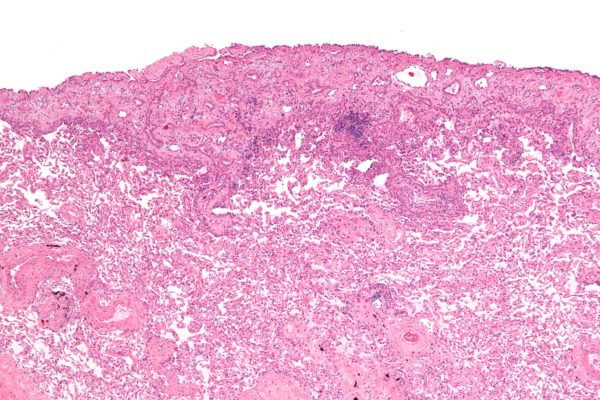Mesothelioma: Signs, Symptoms and Diagnosis
Mesothelioma is a type of cancer that is caused by inhaled asbestos fibers and forms in the lining of the lungs, abdomen or heart.
The disease is most often diagnosed after a person goes to a doctor because of symptoms. If there is a reason to suspect you might have mesothelioma, your doctor will use one or more tests to find out. Symptoms might suggest that the problem could be mesothelioma, but tests will be needed to confirm the diagnosis.
Medical history and physical exam
If you have any signs or symptoms that suggest you might have mesothelioma, your doctor will want to take a complete medical history to learn about your symptoms and possible risk factors, especially asbestos exposure. You will also be asked about your general health.
A physical exam can provide information about possible signs of mesothelioma and other health problems. Pleural mesothelioma can cause fluid to build up around the lungs in the chest (called a pleural effusion). In cases of peritoneal mesothelioma, fluid can build up in the abdomen (called ascites). In pericardial mesothelioma, fluid builds up in the sac around the heart (called a pericardial effusion). Rarely, mesothelioma can develop in the groin and look like a hernia. All of these might be found during a physical exam, such as when the doctor listens to these areas with a stethoscope.
Mesothelioma: Signs and Symptoms of Asbestos Cancer
Mesothelioma: How Is Asbestos Cancer Diagnosed?
If mesothelioma is a possibility, tests will be needed to make sure. These might include imaging tests, blood tests, and other procedures.

Image source: Wikimedia Commons
Imaging tests
Imaging tests use x-rays, radioactive particles, or magnetic fields to create pictures of the inside of your body. Imaging tests may be done for a number of reasons, including to help find a suspicious area that might be cancerous, to learn how far cancer may have spread, and to help determine if treatment has been effective.
Chest X-Ray
This is often the first test done if someone has symptoms such as a constant cough or shortness of breath. It may show an abnormal thickening of the pleura, calcium deposits on the pleura, fluid in the space between the lungs and the chest wall, or changes in the lungs themselves as a result of asbestos exposure. These findings could suggest a mesothelioma.
Computed tomography (CT) scan
The CT scan is an x-ray test that produces detailed cross-sectional images of your body. Instead of taking one picture, like a regular x-ray, a CT scanner takes many pictures as it rotates around you while you are lying on a narrow table. A computer then combines these into images of slices of the body. Unlike a regular x-ray, a CT scan creates detailed images of the soft tissues in the body.
CT scans are often used to help look for mesothelioma and to determine the exact location of the cancer. They can also help stage the cancer (determine the extent of its spread). For example, they can show whether the cancer has spread to other organs. This can help to determine if surgery might be a treatment option. Finally, CT scans can be used to learn whether treatment such as chemotherapy has been helpful in shrinking or slowing the growth of the cancer.
Echocardiogram
This test uses sound waves to look at the heart. It may be done if your doctor suspects that you have fluid around your heart (a pericardial effusion). It can also tell how well the heart is working. For the most common version of this test, you lie on a table while a technician moves an instrument called a transducer over the skin on your chest. A gel is often put on the skin first.
Positron emission tomography (PET) scan
For a PET scan, a radioactive substance (usually a type of sugar related to glucose, known as FDG) is injected into the blood. The amount of radioactivity used is very low. Because cancer cells in the body grow quickly, they absorb more of the sugar than most other cells. After waiting about an hour, you lie on a table in the PET scanner for about 30 minutes while a special camera creates a picture of areas of radioactivity in the body.
The picture from a PET scan is not finely detailed like a CT or MRI scan, but it can provide helpful information about whether abnormal areas seen on these tests are likely to be cancerous or not. For example, it can give the doctor a better idea of whether a thickening of the pleura or peritoneum seen on a CT scan is more likely cancer or merely scar tissue. If you have been diagnosed with cancer, your doctor may use this test to see if the cancer has spread to lymph nodes or other parts of the body. A PET scan can also be useful if your doctor thinks the cancer may have spread but doesn’t know where.
Magnetic resonance imaging (MRI) scan
Like CT scans, MRI scans make detailed images of soft tissues in the body. But MRI scans use radio waves and strong magnets instead of x-rays. The energy from the radio waves is absorbed and then released in a pattern formed by the type of body tissue and by certain diseases. A computer translates the pattern into very detailed images of parts of the body. A contrast material called gadolinium is often injected into a vein before the scan to better show details. This contrast is different than the one used for CT scans, so being allergic to one doesn’t mean you are allergic to the other.
MRI scans can sometimes help show the exact location and extent of a tumor since they provide very detailed images of soft tissues. For mesotheliomas, they may be useful in looking at the diaphragm (the thin band of muscle below the lungs that helps us breathe), a possible site of cancer spread.
Health First: 4 Things to Do If You’ve Been Exposed to Asbestos
Blood tests
Blood levels of certain substances are often higher in people with mesothelioma:
- Osteopontin
- Soluble mesothelin-related peptides (SMRPs), detected with the MesoMark® test
Blood tests for these substances are not used to diagnose mesothelioma, but high levels may make the diagnosis more likely.
If you have been diagnosed with mesothelioma, other blood tests will be done to check your blood cell counts and levels of certain chemicals in the blood. These tests can give the doctor an idea of how extensive the disease may be, and how well organs such as the liver and kidneys are working.
Tests of fluid and tissue samples
Symptoms and test results may strongly suggest that a person has mesothelioma, but the actual diagnosis is made by removing cells from an abnormal area and looking at them under a microscope. This is known as a biopsy. It may be done in different ways, depending on the situation.
Removing fluid for testing
If mesothelioma might be causing a buildup of fluid in the body, a sample of this fluid can be removed by inserting a thin, hollow needle through the skin and into the fluid to remove it. Numbing medicine is used on the skin before the needle is inserted. This may be done in a doctor’s office or in the hospital. Sometimes ultrasound (or an echocardiogram) is used to guide the needle (these use sound waves to take pictures of parts of the body).
This procedure has different names depending on where the fluid is:
- Thoracentesis removes fluid from the chest.
- Paracentesis removes fluid from the abdomen.
- Pericardiocentesis removes fluid from the sac around the heart.
The fluid is then tested to check its chemical makeup and is looked at under a microscope to see if it contains cancer cells. If cancer cells are found, special tests might be able to tell whether the cancer is a mesothelioma, a lung cancer, or another type of cancer.
Even if no cancer cells are found in the fluid, cancer may still be present. In many cases, doctors need to get an actual sample of the mesothelium (the pleura, peritoneum, or pericardium) to determine if a person has mesothelioma.
Needle biopsies
Suspected tumors in the chest are sometimes sampled by needle biopsy. A long, hollow needle is passed through the skin in the chest between the ribs and into the pleura. Imaging tests such as CT scans are used to guide the needle into the tumor so that small samples can be removed to be looked at under the microscope. This is often done using just numbing medicine.
Needle biopsy can also be used to get samples of the lymph nodes in the space between the lungs to see if the cancer has spread there.
Endoscopic biopsies
An endoscope is a thin, tube-like instrument used to look inside the body. It has a light and a lens (or tiny video camera) on the end for viewing and often has a tool to remove tissue samples.
Cancers in the lung often spread to lymph nodes, but mesotheliomas do this less often. Testing the lymph nodes can help show whether a cancer is still localized or if it has started to spread, which might affect treatment options. It can also sometimes help distinguish lung cancer from mesothelioma.
Open surgical biopsy
Sometimes, endoscopic biopsies aren’t enough to make a diagnosis and more invasive procedures are needed. By making an incision in the chest (thoracotomy) or an incision in the abdomen (laparotomy) the surgeon can remove a larger sample of tumor or, sometimes, remove the entire tumor.
Testing the samples in the lab
No matter how they were obtained, all biopsy and fluid samples are sent to the pathology lab. There, a doctor will look at them under a microscope and test them to find out if they contain cancer cells (and if so, what type of cancer it is).
It is often hard to diagnose mesothelioma by looking at cells from fluid around the lungs, abdomen, or heart. It can even be hard to diagnose mesothelioma with tissue from small needle biopsies. Under the microscope, mesothelioma can often look like other types of cancer. For example, pleural mesothelioma may resemble some types of lung cancer, and peritoneal mesothelioma in women may look like some cancers of the ovaries.
For this reason, special lab tests are often done to help tell mesothelioma from some other cancers.
Immunohistochemistry: This test looks for different proteins on the surface of the cells or inside them. It can be used to tell if the cancer is a mesothelioma or a lung cancer, which can sometimes appear to start in the inner lining of the chest.
If mesothelioma is diagnosed, the doctor will also determine what type of mesothelioma it is, based on the patterns of cells seen in the microscope. Most mesotheliomas are classified as either epithelioid, sarcomatoid, or mixed/biphasic.
Pulmonary function tests
If mesothelioma has been diagnosed, pulmonary function tests (PFTs) may be done to see how well your lungs are working. This is especially important if surgery may be an option to treat the cancer. Surgery often requires removing part or all of a lung, so it’s important to know how well the lungs are working to start with. These tests can give the surgeon an idea of whether surgery may be an option, and if so, how much lung can safely be removed.



